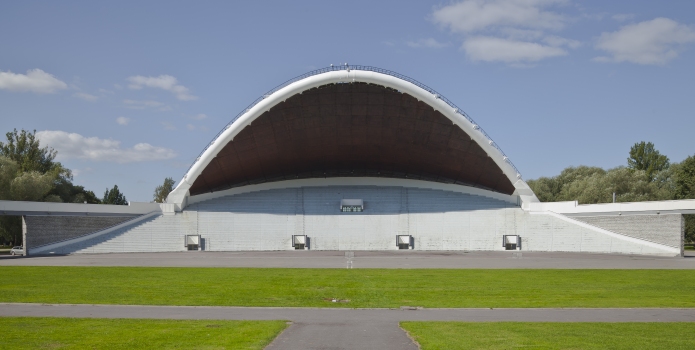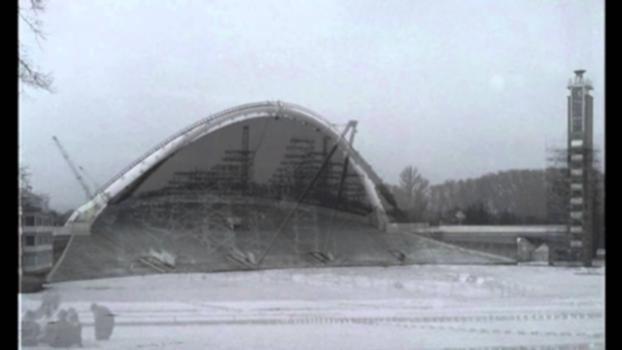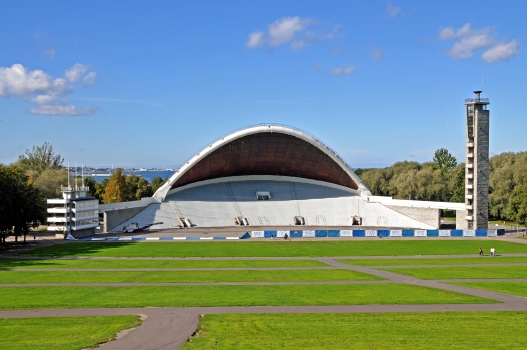General Information
Project Type
| Function / usage: |
Open-air stage |
|---|---|
| Structure: |
Cable net |
| Material: |
roof: Steel structure building: Reinforced concrete structure |
Location
Technical Information
There currently is no technical data available.
Excerpt from Wikipedia
The Tallinn Song Festival Grounds (Estonian:Lauluväljak) are the grounds on which the Estonian Song Festival is held every five years.
History of song festivals
In 1869 Johann Voldemar Jannsen established the Estonian Song Festival while the nation was still a province of the Russian Empire. This festival was considered responsible for fostering an Estonian national awakening. After that, the new tradition was born and the festivals are still held every five years.
Lauluväljak – The Tallinn Song Festival Grounds
The first stage on its current location between Narva Road and Pirita Road in Kadriorg, was built in 1928 for the 9th Estonian Song Festival. It was designed by Karl Burman and provided space for 15,000 performers.
During the Occupation of Estonia by the Soviet Union, there was a need for a larger stage. The new and current arched stage was built in 1959 to celebrate the 20th anniversary of the Estonian SSR in the upcoming year. It was designed by architect Henno Sepmann together with Alar Kotli and Endel Paalmann. The 15th Estonian Song Festival in 1960 was celebrated on the new stage. The stage was meant to hold over 15,000 singers but the reverse also became possible, with the performance taking place in front of the stage and audience sitting on the stage. On the northern side of the song stage is the 42m high fire tower, which is used during the Estonian Song Festivals. It is open for the public all year long.
In 1988, Estonians gathered at the Tallinn Song Festival Grounds, to sing patriotic hymns in what became known as the Singing Revolution that led to the overthrow of Soviet rule.
Also in 1988, three years before the collapse of the Soviet Union and Estonia's reestablishment of independence, an international rock concert called the Summer of Rock (also referred to as Glasnost Rock) took place on the Tallinn Song Festival Grounds between August 26 and 28. Headlining acts included Public Image Ltd (PiL), Big Country and Steve Hackett. The concert attracted over 130,000 attendees. Rock Summer would continue each summer until 1997.
Today, Tallinn's Song Festival Grounds are also used for hosting international acts, such as Iron Maiden, Red Hot Chili Peppers, Michael Jackson, Tina Turner, 50 Cent, Metallica, The Rolling Stones, Elton John, Depeche Mode, Pet Shop Boys, Andrea Bocelli, Madonna, Thirty Seconds to Mars, Lady Gaga, Green Day, José Carreras, Robbie Williams and the contemporary dance music event, the Sundance Festival.
In August 2009, Madonna performed in front of a sold out crowd of 72,067. In June 2006, Metallica gave a concert for more than 78,000 fans. In August 1997, Michael Jackson performed in front of an 85,000 head crowd.
An optimal capacity for concerts is 75,000 fans. In June 1988, during the Singing Revolution days, up to 300,000 people attended the Night Song Festival. In the years to come, however, this figure has been questioned. During the Song Festivals, when the grounds are well packed, the number of people in the audience may reach 100,000.
Text imported from Wikipedia article "Tallinn Song Festival Grounds" and modified on July 23, 2019 according to the CC-BY-SA 4.0 International license.
Participants
Relevant Web Sites
- About this
data sheet - Structure-ID
20076576 - Published on:
18/01/2019 - Last updated on:
18/01/2019










